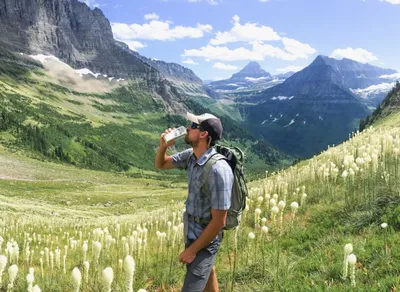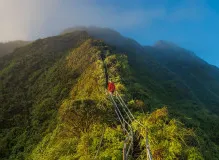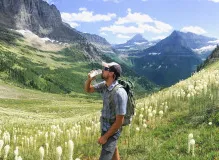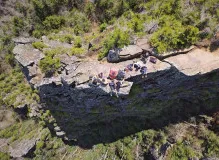For over long years, we have diligently conducted independent research and product testing. When you make a purchase through our links, we may earn a commission.
Trekking: Exploring the World on Foot 🏔️🥾
Created: 10 minutes ago

9 min Read
Trekking is a popular outdoor activity that involves traversing long distances on foot in natural environments, such as mountains, forests, and deserts. It offers a unique opportunity to immerse oneself in nature, challenge personal limits, and discover breathtaking landscapes. In this article, we will delve into the world of trekking, exploring everything from the best hiking trails and gear to essential tips for beginners and the benefits of this adventurous pursuit. So, lace up your hiking boots, and let's embark on a thrilling journey into the world of hiking!
The Best Hiking Trails in the World 🌍
1. Appalachian Trail, United States 🇺🇸
The Appalachian Trail, stretching over 2,180 miles, is a legendary trail renowned for its stunning scenery and challenging terrain. Starting in Georgia's Springer Mountain and ending in Maine's Mount Katahdin, it takes hikers through a diverse array of landscapes, including dense forests, scenic meadows, and picturesque mountains. Along the way, trekkers can expect encounters with wildlife, charming shelters, and the warm hospitality of fellow hikers.
2. Inca Trail, Peru 🇵🇪
For those seeking cultural immersion and breathtaking ruins, the Inca Trail should be on their bucket list. This 26-mile trek leads to the majestic archaeological site of Machu Picchu, traversing ancient Incan stone paths and misty cloud forests. The awe-inspiring blend of history, nature, and panoramic vistas makes this trail an unforgettable experience.
3. Everest Base Camp Trek, Nepal 🏔️🇳🇵
The Everest Base Camp Trek is an iconic journey that takes hiking enthusiasts to the foot of the world's highest peak. Starting in Lukla, the trail winds through remote villages, ancient monasteries, and picturesque valleys until reaching the base camp at an altitude of 17,600 feet. Trekking alongside breathtaking landscapes and looming mountains, this expedition is a true test of endurance and determination.
4. Torres del Paine Circuit, Chile 🏞️🇨🇱
Located in the southernmost reaches of Chilean Patagonia, the Torres del Paine Circuit offers hikers an unrivaled encounter with pristine natural beauty. This 52-mile trek loops around the Paine Massif, treating trekkers to awe-inspiring vistas of glacial lakes, towering granite spires, and sprawling grasslands. With diverse terrain and constantly changing weather conditions, this challenging trail promises an unforgettable adventure.
5. Annapurna Circuit, Nepal 🏔️🇳🇵
The Annapurna Circuit is a classic trek that encircles the Annapurna massif, showcasing Nepal's diverse landscapes, cultural heritage, and stunning mountain vistas. This 128-mile journey takes trekkers through ancient villages, terraced fields, rhododendron forests, and high-altitude passes. The highlight of the trek is Thorong La Pass, standing at an impressive altitude of 17,769 feet.
Essential Trekking Gear and Equipment 🎒🥾
To ensure a safe and enjoyable popular trekking magazines experience, having the right gear and equipment is essential. Here are some key items to consider when preparing for your hiking adventure:
Hiking Boots 👢
Quality hiking and trekking magazine boots are arguably the most important piece of gear for any trek. They provide the necessary support, traction, and protection for your feet during long hours of hiking. Look for boots with sturdy soles, ankle support, and waterproof capabilities. Some popular brands for hiking boots include Salomon, Merrell, and Columbia.
Hiking Backpack 🎒
A proper hiking backpack is crucial for carrying your gear, food, water, and other essentials during your trek. Look for a backpack that fits comfortably on your back, has multiple compartments for organization, and is durable enough to withstand the rigors of the trail. Brands like Osprey, Deuter, and Gregory are well-known for their high-quality hiking backpacks.
Hiking Apparel 👕👖
Wearing the right clothing can greatly enhance your comfort and protect you from the elements. Opt for moisture-wicking and breathable fabrics to keep you dry and comfortable. Layering is also important to adjust to changing temperatures. Don't forget essentials like a waterproof jacket, quick-drying pants, and moisture-wicking socks.
Navigation Tools 🧭🗺️
Having a reliable navigation tool, such as a compass and a detailed topographic map, is essential for staying on track during your trek. While smartphones with GPS capabilities can be useful, it's always wise to have a backup manual navigation system in case of technology failure or limited battery life.
Camping Equipment ⛺
If your trek involves overnight stays, investing in quality camping equipment is necessary. This may include a tent, sleeping bag, sleeping pad, and cooking gear. Consider the weight, durability, and ease of setup when selecting your camping equipment.
Other Essential Items 🌐
In addition to the above gear, there are several other essential items you should pack for your trek. These include:
- Water bottles or a hydration bladder for staying hydrated on the trail.
- Sun protection, such as sunscreen, sunglasses, and a hat, to shield yourself from harmful UV rays.
- First aid kit with basic supplies like band-aids, antiseptic ointment, and pain relievers.
- Headlamp or flashlight for navigating in low-light conditions.
- Trekking poles for added stability and reduced strain on your joints.
- Emergency whistle and fire starter for potential emergency situations.
By investing in high-quality gear and equipment, you'll ensure a comfortable and safe trekking experience.
Hiking Tips for Beginners 🚶♂️🚶♀️
Embarking on your first hiking adventure can be both exciting and daunting. To make the most of this experience, here are some useful tips for beginners:
-
Start with shorter and easier trails: Begin with shorter hikes that match your fitness level and gradually increase the distance and difficulty as you gain experience.
-
Research the trail beforehand: Familiarize yourself with the trail terrain, weather conditions, and any potential hazards. This will help you pack the right gear and adequately prepare for the hike.
-
Pack essentials: Ensure you have enough water, food, extra clothing layers, navigation tools, and emergency supplies. It's better to be over-prepared than underprepared.
-
Wear appropriate footwear and clothing: Invest in proper hiking boots and wear moisture-wicking and breathable clothing to ensure comfort and prevent blisters and chafing.
-
Pace yourself: Take breaks, drink water, and listen to your body. Don't push yourself too hard, especially if you're a beginner. Enjoy the journey and take in the scenery.
-
Follow Leave No Trace principles: Respect the environment by minimizing your impact. Pack out what you pack in, stay on designated trails, and avoid disturbing wildlife.
-
Hike with a buddy or group: Trekking with others enhances safety and provides an enjoyable experience. If hiking alone, inform someone about your plans and expected return time.
-
Stay hydrated and nourished: Drink plenty of water and snack regularly to maintain energy levels. Pack lightweight, high-energy snacks like trail mix, energy bars, and dried fruits.
-
Prioritize safety: Be aware of potential dangers, such as wildlife encounters, weather changes, and falling rocks. Carry a whistle, learn basic first aid, and be cautious in challenging sections.
-
Enjoy the journey: Remember that hiking is not just about reaching the destination but also about immersing yourself in nature, embracing the solitude, and enjoying the process.
Following these tips will ensure a smooth and enjoyable hiking experience for beginners.
The Benefits of Trekking 🌄🧘♀️
Trekking offers numerous physical, mental, and emotional benefits that contribute to overall well-being. Here are some of the key advantages of this adventurous pursuit:
Physical Fitness and Endurance 💪
Trekking is an excellent cardiovascular exercise that helps improve stamina, lung capacity, and overall fitness levels. The varied terrain and inclines encountered during hikes engage multiple muscle groups, including the legs, core, and upper body. By consistently trekking, you can enhance your endurance, strength, and overall physical health.
Mental Clarity and Stress Relief 🧠🌿
Spending time in nature and disconnecting from daily routines can have a profound impact on mental clarity and stress reduction. Trekking offers solitude and the opportunity to escape from the noise and distractions of everyday life. Being surrounded by natural beauty, breathing in fresh air, and immersing yourself in peaceful surroundings can calm the mind, reduce stress, and rejuvenate the spirit.
Connection with Nature and Conservation Awareness 🌿🌎
Trekking allows individuals to form a deep connection with nature, fostering a sense of appreciation and understanding of the environment. Through firsthand experiences, trekkers develop a greater awareness of the fragility of ecosystems, the importance of conservation, and the need to preserve natural spaces for future generations. This connection with nature often sparks a desire to protect and conserve our planet.
Social Interaction and Community Building 👥🥾
Trekking provides opportunities for social interaction, fostering the formation of lasting bonds and friendships. Whether hiking in a group or meeting fellow trekkers along the trail, shared experiences and challenges create a sense of camaraderie and connection. The hiking community is known for its welcoming and supportive nature, making it easy to forge new friendships and be part of a like-minded group.
Personal Growth and Self-Discovery 🌱✨
Trekking pushes individuals out of their comfort zones and challenges their physical and mental limitations. Overcoming obstacles, conquering difficult terrains, and achieving personal goals during a trek contribute to personal growth and self-discovery. Trekking instills self-confidence, resilience, and an appreciation for one's own strength and capabilities.
Trekking Events and Challenges 🏞️⛰️
For those seeking even greater adventures, participating in trekking events and challenges can take hiking to the next level. These organized events provide the opportunity to explore new trails, push personal limits, and connect with fellow adventurers. Here are a few notable trekking events and challenges around the world:
-
The UTMB (Ultra-Trail du Mont-Blanc): This renowned race takes place in the French Alps, covering approximately 105 miles and crossing three countries (France, Switzerland, and Italy). The challenging route attracts elite runners and experienced hikers alike.
-
The Lycian Way Ultra Marathon, Turkey: As one of the world's longest hiking routes, the Lycian Way offers a diverse landscape and captivating historical sites. The ultra marathon challenge covers a distance of 540 kilometers in 10 days.
-
The Annapurna 100, Nepal: This high-altitude ultra trail race is set against the backdrop of the awe-inspiring Annapurna Range. Participants tackle the grueling course, covering a distance of 100 kilometers with a cumulative elevation gain of over 7,500 meters.
Participating in these events not only offers a thrilling adventure but also serves as a test of physical and mental endurance.
Conclusion 🏔️🥾
Trekking is a captivating pursuit that allows us to explore the world on foot, immerse ourselves in nature, and discover the beauty of our planet. From the rugged trails of the Appalachian Mountains to the ancient paths of the Inca Empire, each trek offers a unique experience filled with adventure, personal growth, and awe-inspiring landscapes. By equipping ourselves with the right gear, following essential tips, and embracing the benefits of trekking, we can embark on unforgettable journeys that nourish the body, mind, and soul. So, put on your hiking boots, pack your backpack, and set off on the trail – the wonders of trekking await!
Frequently Asked Questions (FAQs)
What is trekking?
Trekking is a form of hiking that involves multi-day expeditions, typically in rugged and remote natural environments, such as mountains or forests.
Why do people go trekking?
People go trekking to challenge themselves physically and mentally, experience nature and wildlife, explore breathtaking landscapes, and immerse themselves in different cultures.
What are some popular trekking destinations?
Some popular trekking destinations include the Everest Base Camp Trek in Nepal, the Inca Trail in Peru, the Annapurna Circuit in Nepal, the Mont Blanc Circuit in France, and the Appalachian Trail in the United States.
What essential gear do I need for trekking?
Some essential gear for trekking includes sturdy hiking boots, a backpack, appropriate clothing layers, a sleeping bag, a tent, a water purifier, a map, a compass, and a first aid kit.
How physically demanding is trekking?
Trekking can range from moderate to extremely physically demanding, depending on the difficulty of the trek. It is important to choose a trek that matches your fitness level and prepare accordingly.
Is previous hiking experience necessary for trekking?
While previous hiking experience can be helpful, it is not always necessary for trekking. However, being physically fit and mentally prepared is crucial for a successful trekking experience.
Are guides recommended for trekking?
For inexperienced trekkers, hiring a local guide or joining a guided trekking tour is recommended. Guides have local knowledge, provide safety, and enhance the overall trekking experience.
What is the best time of year for trekking?
The best time for trekking varies depending on the destination. Generally, the spring and autumn seasons offer the most favorable weather conditions for trekking.
What are the potential risks of trekking?
Some potential risks of trekking include altitude sickness, injuries from falls or accidents, adverse weather conditions, and encountering wildlife. It is important to be prepared and take necessary precautions.
How can I minimize my impact on the environment while trekking?
To minimize your impact on the environment while trekking, follow designated trails, pack out all trash, avoid wildlife disturbance, use biodegradable toiletries, and respect local customs and cultures.


